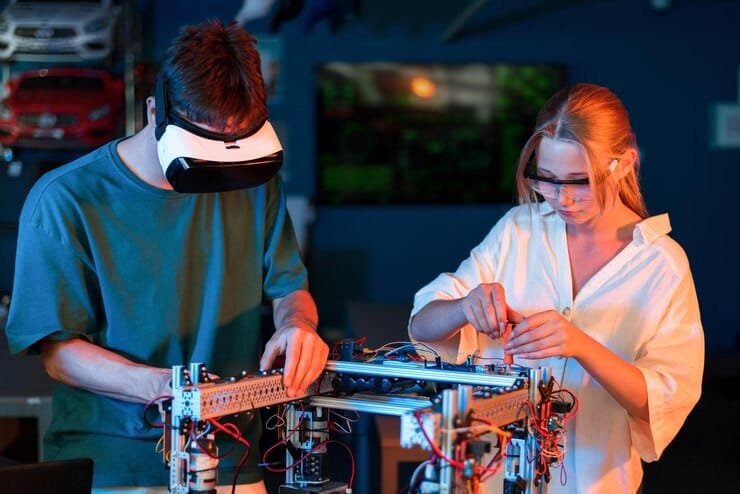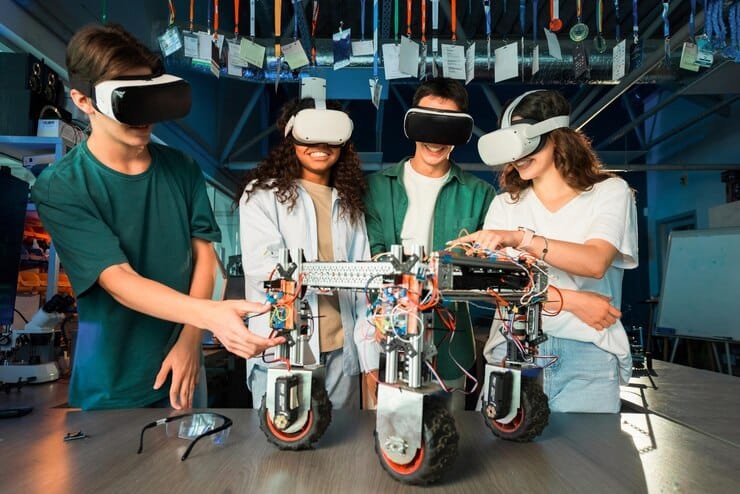Overview: The Body Electric: How Implantable Devices are Rewiring the Electronics Industry
Imagine a world where technology doesn’t just exist around us, but within us, working in perfect harmony with our bodies to restore health and enhance well-being. That world isn’t a futuristic fantasy; it’s the reality we are actively building within the implantable medical devices landscape. We stand at a pivotal moment, a convergence of medical science and cutting-edge electronics that is revolutionizing healthcare as we know it. From pacemakers that have kept hearts beating strong for decades to sophisticated neurostimulators that offer relief from chronic pain, implantable devices have already transformed countless lives. But this is just the beginning.
This is not just about creating smaller gadgets; it’s about engineering deeply integrated solutions that can interpret the body’s subtle signals and respond with precise therapeutic interventions. As innovators and leaders in this field, we’re not just pushing the boundaries of what’s possible – we’re rewriting the rules of what it means to heal, empower, and ultimately, live fully. As the great Maya Angelou eloquently said, “Each time a woman stands up for herself, without knowing it possibly, without claiming it, she stands up for all women.” Likewise, every leap we take in implantable device technology isn’t just a victory for our field, but a triumph for human potential.
This blog post is not a mere analysis of trends; it’s a call to action. We will explore the exciting pathways being forged, from innovative biomaterials to advancements in power management. We will discuss the profound impact these devices have on patient care and the immense opportunities they present for both established companies and aspiring entrepreneurs alike. We’re here to spark your imagination, empower your decision-making, and inspire you to join us in shaping the future of medicine, one innovative implantable device at a time. Let’s delve into the exciting world of “The Body Electric” and see how together we are rewiring not just the electronics industry, but the very fabric of healthcare itself.
Alright, let’s dive into the vibrant world of implantable medical devices! It’s a sector brimming with potential, where innovation meets the profound human need for better health. We’re not just talking about devices here, we’re talking about life-enhancing, transformative solutions that are rewriting the story of healthcare. And yes, there are challenges too, but as the great Nelson Mandela once said, “It always seems impossible until it’s done.” Let’s see how the current trends are shaping this incredible landscape and what that means for companies ready to seize the future.

Positive Trends: A Galaxy of Opportunities
- Miniaturization and Advanced Materials: We are witnessing a remarkable trend towards smaller, more sophisticated implants made with biocompatible and intelligent materials. Think of pacemakers shrinking to the size of a vitamin capsule, or neurostimulators that are incredibly adaptable. This is propelled by advancements in nanotechnology and material science. Impact: This opens doors for less invasive procedures, improved patient comfort, and potentially a wider patient reach. Example: Companies like Medtronic are pioneering micro-implants, illustrating this trend beautifully.
- Digital Health Integration & Remote Monitoring: The convergence of implantable devices with digital health platforms is transformative. Imagine continuous glucose monitoring devices transmitting data directly to a patient’s smartphone, or cardiac implants providing real-time updates to doctors. This is driven by the growing demand for personalized, proactive healthcare. Impact: Improved patient outcomes, reduced hospitalizations, and new avenues for data-driven healthcare solutions. Example: Abbott’s FreeStyle Libre system exemplifies this trend, offering constant glucose data with immediate access for patients.
- Personalized Medicine and 3D Printing: Customized implants tailored to individual patient needs, thanks to 3D printing, are becoming a reality. This is fuelled by a deeper understanding of genomics and the unique anatomical variations between individuals. Impact: Higher success rates for implant procedures, reduced rejection rates, and better long-term performance of devices. Example: Companies like Stryker are leading the way in 3D-printed implants for joint replacements.
Adverse Trends: Navigating the Rapids
- Stringent Regulatory Landscape: The rigorous approval processes and safety standards associated with implantable devices can be lengthy and expensive, presenting a significant barrier to entry. This is vital for safety, yet poses a challenge to smaller or newer businesses. Impact: Delayed market launches, increased operational costs, and potential for regulatory compliance hurdles.
- Data Privacy and Security Concerns: As implantable devices become more connected, data security and patient privacy are paramount. Breaches or misuse of sensitive medical data can have severe consequences. Impact: Reputational damage, loss of patient trust, and potential legal liabilities.
- Cost of Innovation and Affordability: The high cost associated with researching, developing, and manufacturing cutting-edge implantable devices raises concerns about accessibility and affordability, especially in developing nations. Impact: Inequitable access to advanced healthcare solutions, potential market limitations.
Actionable Insights: Charting the Course
- Leverage Positive Trends:
- Invest in R&D: Focus on miniaturization, biocompatible materials, and digital health integration to create innovative, patient-centric solutions.
- Embrace Data Analytics: Use the wealth of data generated by implantable devices to personalize treatments and improve patient outcomes.
- Form Strategic Partnerships: Collaborate with digital health companies, research institutions, and material science experts to accelerate innovation.
- Mitigate Adverse Trends:
- Proactive Regulatory Compliance: Develop robust quality management systems and engage proactively with regulatory bodies to streamline the approval process.
- Prioritize Cybersecurity: Invest in state-of-the-art security measures to safeguard patient data and build trust.
- Value-Based Healthcare: Explore innovative pricing models and collaborations with healthcare providers to ensure affordability and accessibility.
The implantable medical device market is not merely a business; it’s a catalyst for transforming lives. By embracing innovation, prioritizing patient well-being, and addressing challenges head-on, companies in this sector have the unique opportunity to make a profound and lasting impact on the world. Let’s take bold strides forward, with courage, compassion and the unwavering belief that together, we can build a healthier future. “The future belongs to those who believe in the beauty of their dreams.” – Eleanor Roosevelt. The dream of better health, it’s a dream worth fighting for.
Healthcare: In hospitals, advanced pacemakers and implantable cardioverter-defibrillators (ICDs) are now routinely monitored remotely, transmitting crucial data directly to cardiologists. This proactive approach reduces hospital readmissions and allows for timely interventions, preventing potential heart failures. Imagine the peace of mind this gives both patients and their families; it’s a testament to how technology can truly empower life! Strategically, healthcare providers can leverage this remote monitoring data for predictive analytics, further optimizing patient care pathways.
Technology: Companies are exploring innovative ways to integrate implantable sensors for enhanced biometric data collection. Think of athletes using implanted sensors to monitor glucose levels and hydration in real-time for optimized performance. “The only way to do great work is to love what you do.” Steve Jobs’ words ring true here; the data collected through these devices could lead to revolutionary training techniques and personalized nutrition plans, creating a whole new market for athletic wearables. Businesses should be investing in data analysis platforms for this specific use case.
Manufacturing: In high-risk manufacturing environments, implantable sensors are being explored for early detection of worker fatigue or stress. This real-time biofeedback system could drastically reduce workplace accidents, fostering a safer and more productive environment. It’s not just about safety but also about understanding and empowering the workforce. Consider incorporating personalized feedback mechanisms based on collected data into company wellness programs.
Automotives: Imagine a future where your car can intuitively respond to your physiological state. Some companies are researching implantable sensors that monitor driver alertness and cognitive load. If a driver becomes drowsy or distracted, the vehicle could autonomously initiate safety features or suggest a break. This is not science fiction; it is the path to making our roads safer. “The future belongs to those who believe in the beauty of their dreams.” – Eleanor Roosevelt, and we must believe in this and invest in the research and the market.
Actionable Advice: For leaders: embrace collaboration across industries to maximize the potential of implantable medical devices. Invest in R&D for biocompatible materials and advanced data analytics. For professionals: hone your expertise in data security and ethical considerations, as these will be critical moving forward. The opportunity to revolutionize lives is in our hands; let’s grasp it!
Organic Growth Strategies:
- Focus on Next-Gen Miniaturization: A major push is happening to make implants smaller and less invasive. Think of it like how smartphones shrunk over time. Companies are investing heavily in R&D to develop micro-implants with enhanced functionality and reduced battery needs. One engineer I know, let’s call her Sarah, told me about the hurdles in fitting complex circuitry into a device the size of a grain of rice – that’s the kind of cutting-edge work being pursued. This is not just about size; it is about improving patient comfort and speeding up recovery times.
- Smart Material Integration: Another powerful strategy focuses on using bio-compatible and smart materials that can adapt to the body’s changing needs, or that promote better integration. Imagine an implantable device that can sense inflammation and release medication locally, preventing systemic side-effects. Companies are working on implants that can reduce scarring, actively adapt to the tissue and even become part of it. It’s akin to building implants that are not just foreign bodies but work in harmony with the human system.
- Data-Driven Personalization: Companies are increasingly focusing on harnessing patient data to tailor implants and treatment plans. For example, post-implantation, devices can transmit real-time health data to doctors to customize treatment protocols, predict potential complications, or tweak medication dosages. I’ve personally seen how this data-driven approach helps in quicker adjustments, reduces hospital readmissions, and improves patient outcomes. It’s all about moving towards truly personalized medicine.
Inorganic Growth Strategies:
- Strategic Acquisitions of Innovative Tech: Companies are actively acquiring start-ups and smaller firms that have unique, disruptive technologies. These are not the old-fashioned mergers; think of it as acquiring specialized skill sets and cutting-edge innovation quickly. For example, if a smaller firm has a groundbreaking new coating technique, a larger player might acquire them to integrate that into their existing product line, accelerating product improvement.
- Collaborations and Partnerships: There is a notable increase in collaborative efforts. Companies with complementary capabilities are forming partnerships to accelerate innovation and get to the market faster. For instance, an electronics company specializing in sensors might partner with an implantable medical device company to create a sophisticated implant. It’s not always about competing, it’s about recognizing that collaborating opens up opportunities for exponential growth.
- Expanding into New Geographies: Companies are also looking beyond traditional markets. They are moving into emerging markets where there is a growing need for implantable medical devices. This is not just about increasing sales; it’s about making innovative healthcare accessible to wider populations. By strategically entering new geographic markets, companies secure a stronger global foothold.

Outlook & Summary: A Future Powered Within
The journey we’ve explored in “The Body Electric” reveals a monumental shift: implantable medical devices are not just a niche; they are a powerful current reshaping the entire medical electronics landscape. Over the next 5 to 10 years, we stand on the precipice of truly revolutionary advancements. Think beyond pacemakers – imagine closed-loop systems that proactively manage chronic conditions, personalized neural interfaces that restore lost function, and biocompatible sensors providing real-time, preventative health data. This isn’t science fiction; it’s the path we’re forging with ingenuity and collaboration. We’ll see a convergence of materials science, microelectronics, and AI, driving an unprecedented era of patient-centric, proactive healthcare. As a team of specialists, this space demands your continued passion to innovate and collaborate, not only within the implantables market but to become the torchbearers within medical electronics.
Remember the words of Walt Disney: “All our dreams can come true, if we have the courage to pursue them.” This field, more than most, embodies that spirit. The key takeaway from our exploration? Implantable medical devices are no longer just about treatment; they are about empowerment, about giving individuals control over their well-being and their futures, thereby reshaping the entire medical electronics sector. The potential is boundless, and our collective efforts will define the next chapter of human health. Are you ready to be part of this incredible transformation, and what role will you play in ushering in this future?


